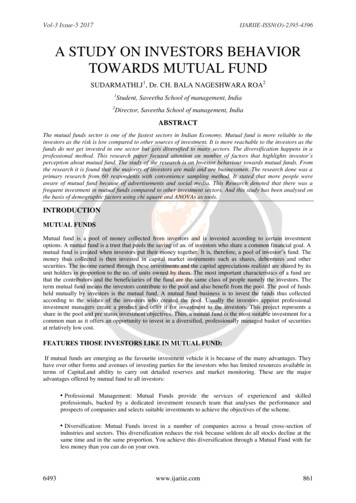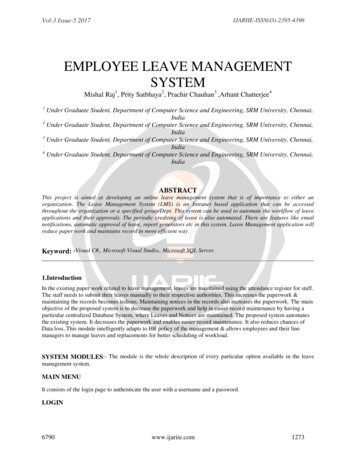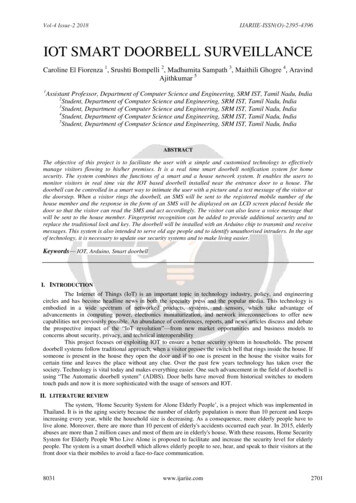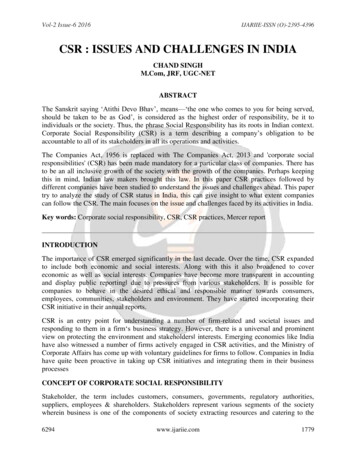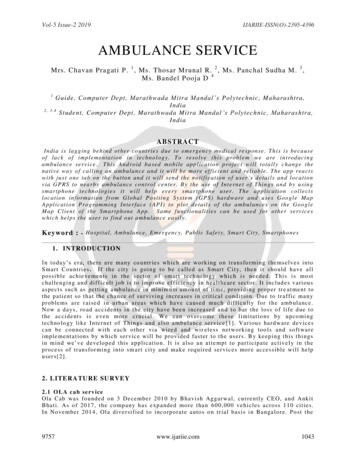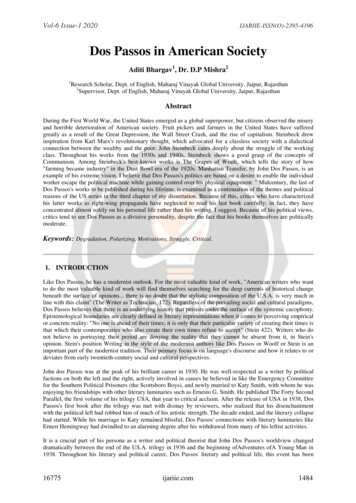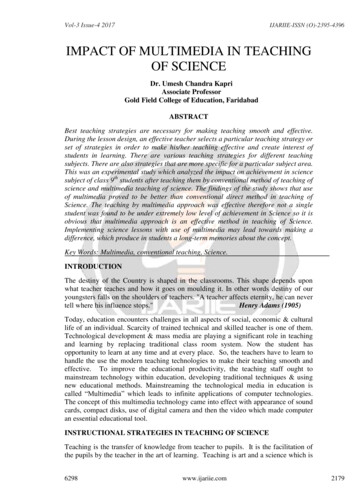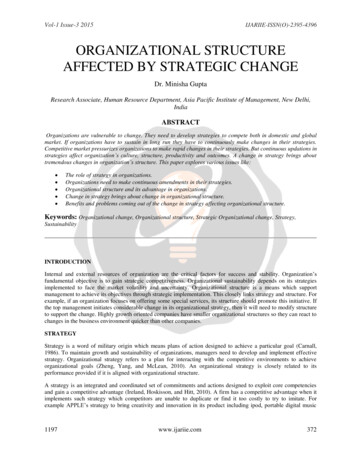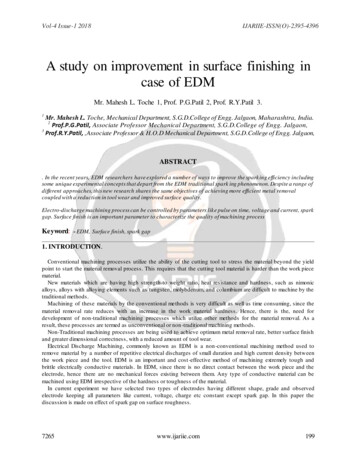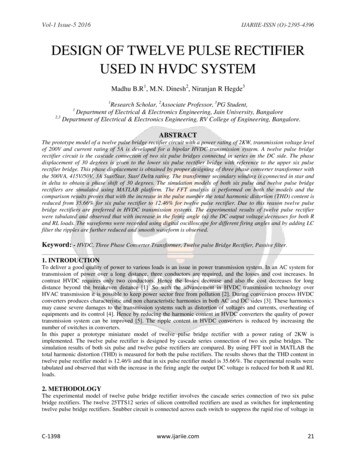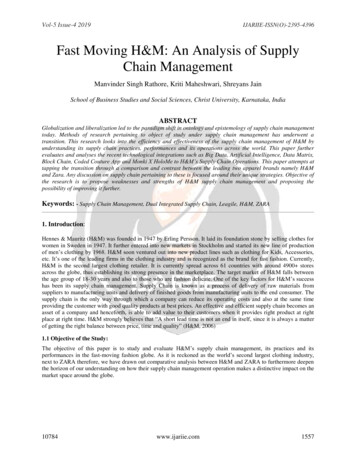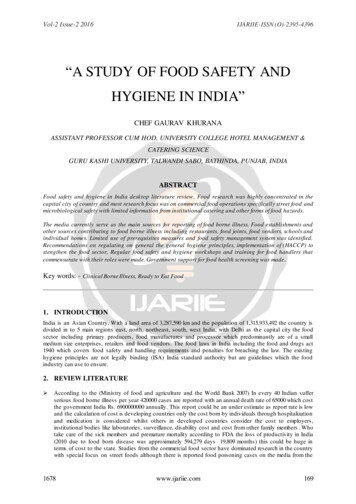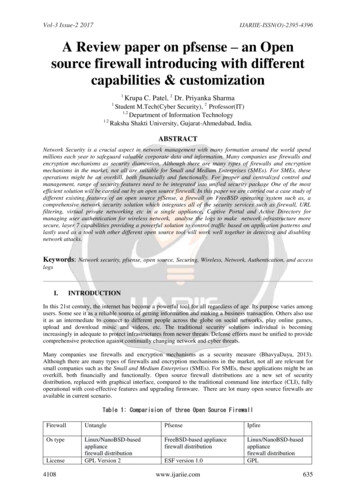
Transcription
Vol-3 Issue-2 2017IJARIIE-ISSN(O)-2395-4396A Review paper on pfsense – an Opensource firewall introducing with differentcapabilities & customization1Krupa C. Patel, 2 Dr. Priyanka Sharma1Student M.Tech(Cyber Security), 2 Professor(IT)1.2Department of Information Technology1.2Raksha Shakti University, Gujarat-Ahmedabad, India.ABSTRACTNetwork Security is a crucial aspect in network management with many formation around the world spendmillions each year to safeguard valuable corporate data and information. Many companies use firewalls andencryption mechanisms as security diamention. Although there are many types of firewalls and encryptionmechanisms in the market, not all are suitable for Small and Medium Enterprises (SMEs). For SMEs, theseoperations might be an overkill, both financially and functionally. For proper and centralized control andmanagement, range of security features need to be integrated into unified security package One of the mostefficient solution will be carried out by an open source firewall. In this paper we are carried out a case study ofdifferent existing features of an open source pfSense, a firewall on FreeBSD operating system such as, acomprehensive network security solution which integrates all of the security services such as firewall, URLfiltering, virtual private networking etc in a single appliance, Captive Portal and Active Directory formanaging user authentication for wireless network, analyse the logs to make network infrastructure moresecure, layer 7 capabilities providing a powerful solution to control traffic based on application patterns andlastly used as a tool with other different open source tool will work well together in detecting and disablingnetwork attacks.Keywords: Network security, pfsense, open source, Securing, Wireless, Network, Authentication, and accesslogsI.INTRODUCTIONIn this 21st century, the internet has become a powerful tool for all regardless of age. Its purpose varies amongusers. Some see it as a reliable source of getting information and making a business transaction. Others also useit as an intermediate to connect to different people across the globe on social networks, play online games,upload and download music and videos, etc. The traditional security solutions individual is becomingincreasingly in adequate to protect infrastructures from newer threats. Defense efforts must be unified to providecomprehensive protection against continually changing network and cyber threats.Many companies use firewalls and encryption mechanisms as a security measure (BhavyaDaya, 2013).Although there are many types of firewalls and encryption mechanisms in the market, not all are relevant forsmall companies such as the Small and Medium Enterprises (SMEs). For SMEs, these applications might be anoverkill, both financially and functionally. Open source firewall distributions are a new set of securitydistribution, replaced with graphical interface, compared to the traditional command line interface (CLI), fullyoperational with cost-effective features and upgrading firmware. There are lot many open source firewalls areavailable in current scenario.Table 1: Comparision of three Open Source FirewallFirewallUntanglePfsenseIpfireOs typeLinux/NanoBSD-basedappliancefirewall distributionGPL Version 2FreeBSD-based appliancefirewall distributionLinux/NanoBSD-basedappliancefirewall distributionGPLLicense4108ESF version 1.0www.ijariie.com635
Vol-3 Issue-2 esYesYesYesI386, x86 64YesCLI and GUII386, x86 64YesCLI and GUII386, x86 64YesCLI and GUIYesYesYesNoYesYes ( Since IPFire ipfire.org/downloadFreeBy comparing all open source firewall, pfSense meets the objectives required for this paper to implement withmodern security extensions and solutions.II.THE PFSENSE PLATFORMpfSense is a customized FreeBSD distribution, primarily oriented to be used as a firewall and router. It started asa fork of the m0n0wall project. m0n0wall was mainly directed towards embedded hardware installations.pfSense, on the other hand, it is mainly focused on full PC installations, despite the fact that pfSense also offerssolutions for embedded hardware. It consists of many base features, and can be extended with the packagesystem, including “one touch” installations.pfSense is currently a viable replacement for commercialfirewalling/routing packages, including many featuresfoundon commercial products (Cisco Pix, SonicWall, WatchGuard).The list of features, among others, includethe following: firewall, routing, QoS differentiation, NAT, Redundancy, Load Balancing, VPN, Report andMonitoring, Real Time information,and a Captive Portal. It is fully prepared for highthroughput scenarios (over500 Mbps), as long as high endserver class hardware is used.PfSense uses a single XML file, called config.xml, which stores the configuration of all services available in thepfSense machine. The code responsible for the operation of the distinct pfSense services is essentially written inPHP, which makes easy to extend the current code base, improving existing features or adding new ones.III.A.LITRACURE REVIEWImplementing UTM based on pfsense platformDefense efforts must be unified to provide comprehensive protection against frequently changing network andcyber threats. UTM generally refers to a security appliance that consolidates a wide range of essential networksecurity functions into a single device. UTM brings the following network security technologies in to a singleplatform: Firewall, Anti-spam, Anti-virus, URL filtering, Virtual Private Network (VPN).Two types of UTM are used: A. Hardware/Appliance based UTM; B. Software/Appliance based UTM.In this paper, we implemented UTM based on pfsense rather than hardware/software Appliance, two mainfactors contributed to this reasoning. First, this approach can be cost-effective than hardware/software based.The second factor is the stability of it, makes less failure for our network. The main objective behind oursolution was to mitigate bandwidth as well as the cost. The basic idea is that when a user visits a web site, thecontent of the page are cached on a proxy server. The next time that person visits that web page content does nothave to be downloaded because it already exists in the cache. And using squidGuard on WAN interface to filterURL address. Squid3 proxy server caching the web supporting HTTP, HTTPS, FTP and etc.it caches all IPsubnet with high range of users with low error ratio.4108www.ijariie.com636
Vol-3 Issue-2 2017IJARIIE-ISSN(O)-2395-4396Implementation results shows optimization of bandwidth having graph with 20MB bandwidth and 600 activeusers, and minimizing required resources as squid3 proxy continuously caching on pfsense, on the other hand alot of services is running on pfsense but CPU usage is low.As a conclusion, pfsense is a powerful open source UTM with many advanced features and services thatdemonstrates a good performance in a big organization , it reduces complexity and costs, easy to manage withhigh reliability but need some proper and easy way that was based on user.B.Securing Wireless Network Using pfSense Captive Portal with RADIUS Authentication – A CaseStudy at UMaT*In a WLAN, communication and data transfer use radio transmission, which is open to all users. For that it usesWEP, WPA/TKIP, WPA2 chronologically. However, some researchers have uncovered a vulnerability in theWPA2, which is the strongest for Wi-Fi encryption and authentication currently standardized and available.Hence, to improve the security of WLAN, a new secure mechanism called Captive Portal has been introducedwhich uses a webpage to authenticate users.In order to use pfSense Captive Portal for UMaT wireless network, pfSense has to be installed on a server andconfigured with one LAN interface to assign an IP to the appliance. The LAN interface has to be assigned astatic IP address and default gateway. Every user on pfSense LAN has to pass through this default gatewaybefore he/she reaches WAN network.By using the experiment setup, weinvestigate the following:1. How to configure pfSense Captive Portal?2. How to configure RADIUS server?3. How to set the policy and securitymechanism?4. How to manage user credential?Fig- 1: setup4108www.ijariie.com637
Vol-3 Issue-2 2017IJARIIE-ISSN(O)-2395-4396Result and discussions shows how to configure and implement all the above questions. As This paper aims atdisabling concurrent logins for Captive Portal, hence, provision was made by generating vouchers for guest orvisitors to the university to also have access to the internet.The experiment conducted demonstrated how to achieve the configuration of pfSense Captive Portal and a localRADIUS server for authenticated users on a wireless network and secure their credentials. A user connected tothe wireless network is assigned an IP address by the Dynamic Host Configuration Protocol in the pfSense andany web request from the user is redirected to the Captive Portal page. This paper sort to find a simple way toincorporate already existing users in an AD to communicate with the Captive Portal instead of manuallyentering details into the pfSense local user account. The approach used by Mamat and Ruzana (2013) will bedifficult for large organisations. In the future to enhance the level of security at the OSI reference model layer 7by protecting a range of attacks against web applications and also to allow for HTTP traffic monitoring, logging,and real-timeanalysis.C.Network security with open source firewallInformation technology changes regularly and it is very important to protect our systems and networkinfrastructure from compromising. So the main purpose of this educational research is to test the weaknesses ofthe secure and unsecured environments .The aim of this research is to analyse the system logs that are generated in the virtual environment (Which issecure with pfsense firewall). The method used in this research is „Whitebox Testing‟. Whitebox testing is thepart of the penetration testingThe tools & script used in this testing are,1. Nmap (Network Mapper)2. traceroute3. tcptraceroute4. NmapFirewalk Script5. XPROBE26. ARMITAGEThey do information gathering, scanning of system, generate log with above tool in addition to that they showsresults of with pfsense firewall result and without firewall result.After the white box testing , from the pfsense firewall logs we can understand that attacking pattern of a hackeror intruder . Also we can find out the behaviour of attack . How, by analysing those protocols, flags – ,ack, fin ,ports and the ports number . Even administrator, security expert can study these attacking pattern from the logsand he can protect its own network infrastructure or after studying this type of virtual environments , he canredefine his secure physical infrastucture. In short this whole research helps us to upgrade our network securitywith the help of open source firewall.Future research includes, This research helps in the logical and practical implementation of the firewall security to make networkenvironments more secure . This research helps administrator to understand the attack. He can analyse and trace attacker with the help of firewall logs. It helps to make your system more secure and network infrastructure more secure. It helps students to understand how things are actually going behind the scenes. We can test different types of attacks on virtual environment. The logs analysis helps network administrator to understand what happen when an attack is done. LikeDdosattack , Decoy attack etc. Without breaking any cyber law . Also we can analyse the log and see which Tcp ports are used during the attacks so that in future wecan close that ports .D.Open Source Versus Commercial Firewalls: Functional Comparison*This paper performs an experiment to compare two firewall alternatives with the capability of deploying VirtualPrivate Networks (VPNs) over the Internet, one being an open source software solution and the other being aproprietary commercial product. This research provides analysis to the current security debate between “opensource” and “security-by-obscurity” solutions.Two specific firewall solutions are compared highlighting corresponding security risks:(1) a firewall constructed using only open source software available for the Linux operating s.wtem and4108www.ijariie.com638
Vol-3 Issue-2 2017IJARIIE-ISSN(O)-2395-4396(2) a commercial jrewall solution from Cisco using the Cisco 10s firewall feature setComparison of Firewall Alternatives are based on network level filtering, application level filtering and VPNcapabilities.Experimental Resultsshows that the Linux firewall has consistently higher transaction throughput rates for rulesets varying from 0 to 200 rules and for packet sizes of both 1 and 128 bytes. So it concluded that Linuxfirewall has superior transaction rate performance and application-level filtering capabilities. The Cisco 10sfirewall is functionally superior for network level filtering, VPN capabilities. Ultimately, the most effectivefirewall solution may be a combination of both application level and network level packet filtering. Thisexperiment demonstrate a basis for future experiments building toward general conclusions between opensource implementations versus general commercial implementations.E.L7 Classification and Policing in the pfSense PlatformThe traditional way to organize traffic entering a network domain is usually based on network and transport datafields, e.g. service class marks, source and/or destination IP addresses and ports. Although in many cases thistype of classification provides a good compromise between simplicity and efficacy. In this context, performingtraffic classification and policing at the application layer (layer 7 or L7 in short) can be a convenient solution toconquer these limitations. In L7 classification, user traffic can be identified based on an application pattern.Examples of related work on L7 classification include IPCop Firewall and Bandwidth Arbitrator . AlthoughIPCop can support classification by application protocol, it does not allow the definition of shaping policies,only accepting blocking policies. In the present work, we study and tackle the L7 classification paradigm for thepfSense platform. Although pfSense already includes support for traffic classification at application layer, itdoes not introduce that capacity to the user.In this context, we have established the following goals: i) to develop mechanisms to control the classificationcomponent in the application protocol, consolidating them in the platform through a graphical interface; ii) todefine and implement user-friendly wizards to clarify the configuration of QoS rules; iii) to plan and develop atest platform which allows testing multiple patterns of applications simultaneously, and to measure theperformance (e.g. response time) of the classification module based on the application layer.After the implementation, It is concluded that pfSense has now another shaping mechanism, that puts it on parwith a extent amount of commercial solutions, and it also has now a fully integrated GUI that grant the end userto easily leverage the layer 7 capabilities that ipfw-classifyd provides to the pfSense platform. The only currentdrawback in that ipfw-classifyd is not currently fully operational due to ongoing improvements.As future work, we think there is still some room for improvement. In particular, performing L7 inspectiondirectly in kernel land would be very essential and should be faced as a top goal. This would avoid the overheadintroduced by the context switch between kernel and user land, that is crucial to divert IP packets from thekernel to ipfw-classifyd or to other application for that purpose.F.Design of a Network Security Tool Using Open-Source ApplicationsMany companies use firewalls and encryption mechanisms as a security measure. Although there are manytypes of firewalls and encryption mechanisms in the market, not all are suitable for small companies such as theSmall and Medium Enterprises (SMEs). For SMEs, these applications might be an overkill, both financially andfunctionally. This paper proposes the design of Network Defender, a network security tool, based on opensource applications.Network Defender is composed of four components namely Firewall, Network Intrusion Detection,Vulnerability Scanner and Exploit Tool. The value of this design was demonstrated by the implementation ofNetwork Defender using PfSense, Snort, Nmap and Metasploit. Test results show that all four componentswork well together in detecting and disabling network attacks. The usage of Metasploit also enable reverseattacks to be carried out.Test results show that all components work well together in detecting and disabling network attacks.Future work include the inclusion of other tools and applications such as SMS alerts and centralized database tobetter equipped Network Defender against attacks. It is hoped that this study has provided a cheaper alternativeto SMEs in guarding their network.4108www.ijariie.com639
Vol-3 Issue-2 2017IJARIIE-ISSN(O)-2395-4396Table 2: Summarization of literature surveySr. NoNameAdvantagesDisadvantages1Implementing UTM basedon pfsense platformIt consolidates a wide range ofessential network securityfunctions into a single deviceIt needs some proper andeasy way that was based onuser.2Securing Wireless NetworkUsing pfSense CaptivePortal with RADIUSAuthentication – A CaseStudy at UMaT*It improves the security ofWLAN,Captive Portal has beenintroduced which uses a webpageto authenticate users.It will be difficult for largeorganisations.3NETWORK SECURITYWITH OPENSOURCEFIREWALLAll the tools used in testingare not included in pfsenseplatform.4Open Source VersusCommercial Firewalls:Functional Comparison*L7 Classification andPolicing in the pfSensePlatformBy using penetration testingapproach,attacking pattern of ahacker or intruder and behaviourof the attack can be understoodOpen source provides more or lesssimilar function to commercialfirewallIt allows the end user to easilyleverage the layer 7 capabilitiesthat ipfw-classifyd provides to thepfSense platform.56Design of a NetworkSecurity Tool Using OpenSource ponents work well together indetecting and disabling networkattacks.Somewhat implementationneeded in open sourcefirewall.The current drawback in thatipfw-classifyd is notcurrently fully operationaldue to ongoingimprovements.There are some room forimprovement for addingmore functionality needed tosecure network byobsecurity.IV. CONCLUSIONAll through the examination work, outrageous investigation of the firewall, it is inferred that for little to mediumsize business an open source firewall gives the best chance to secure their system from various digital dangers.Despite all other open source firewall, pfSense demonstrated the most suitable firewall since the majority of theelements are upheld by least equipment prerequisites and in addition free permit administrations empower theutilization of these firewall. Pfsense gives incredible functionalities and elements. It gives secured associationthrough hostage entryway. It utilizes all techniques IP based. Encourage execution is to enhance this as clientbased.V. REFERENCES[1]. Ed Tittel, Unified Threat Management for Dummies, copyright 2012 by John Wiley & Sons, Inc.,Hoboken, New Jersey[2]. K RAJESH, “HARDWARE Vs. SOFTWARE UTM AND OPEN SOURCE UTM”[3]. VIVEK GITE, Debian, “Ubuntu Linux: Install squidGuard web Filter plugin for squid3 x to blockunwanted sites”, unpublished[4]. Anon., (2011), “Cisco” ecureYourNetwork ,Accessed: 27th February, 2016.[5]. Danen, V. (2009), “Tech Republic”, tures-reliability-and-security,Accessed: 17th March, 2016.4108www.ijariie.com640
Vol-3 Issue-2 2017IJARIIE-ISSN(O)-2395-4396[6]. Mamat, K, Ruzana Mohamad Saad; “Home Wireless Network Security Using pfSense Captive Portal”,Proceedings of 8th International Conference on IT in Asia 2013 (CITA'13) {IEEE/SCOPUS/ISI},Accessed:12th April, 2016.[7]. Stahie, S. (2014), “Softpedia”, http://news.softpedia. Any-Commercial-Alternative-436111.shtml, Accessed: 21stFebruary, 2016.[8]. Lee Allen , Advanced Penetration Testing for Highly Secured Environments: The Ultimate SecurityGuide,Packt Publishing , www.packetpub.com[9]. www.wikipedia.org[10]. ShakeelAli,TediHariyanto, Backtrack 4 : Assuring Security by Penetration Testing , Packt Publishingwww.packetpub.com[11]. “TIS Firewall Toolkit Configuration and Administration,” Trusted Infomation Systems, Inc.[12]. pfSense Project. URL: http://www.pfsense.com/, 2004.[13]. A. Seddik-Ghaleb, Y. Ghamri-Doudane, and S.-M. Senouci. Emulating End-to-End Losses and Delaysfor Ad Hoc Networks. Communications, 2007. ICC apos; 07. IEEE International Conference, 2428:3224–3231,June 2007.[14]. BhavyaDaya, 2013. “Network Security: History, Importance, and Future”. University of g.http://web.mit.edu/ bdaya/www/Network%20Security.pdf.[15]. BSD Perimeter LLC, 2004-2011. PfSense. http://www.PfSense.org/.[16]. Firewall (computing), 2013.http://en.wikipedia.org/wiki/Firewall %28computing%29.[17]]. Network Working Group of the IETF, 2013. “The Secure Shell (SSH) Authentication Protocol”.http://en.wikipedia.org/wiki/Secure shell.[18]. Acosta, David. 2014. PCI DSS engineering controls part II: Firewall (Firewall), PCI HISPANO.Available at ci-dss-parte-ii-cortafuegos-firewall/.[Accessed : 19.05.2015][19]. Firewall (Computing) 2015 Available at: http://en.wikipedia.org/wiki/Firewall (computing)[Accessed at : 03.06.2015]4108www.ijariie.com641
Open source firewall distributions are a new set of security distribution, replaced with graphical interface, compared to the traditional command line interface (CLI), fully operational with cost-effective features and upgrading firmware. There are lot many open source firewalls are available in current scenario. .
